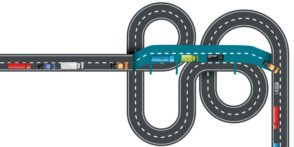Under Lock & Key
We asked four industry leaders for their take on the value of interlocks and the current fight against drunk driving in the United States
Political Will
Jonathan Adkins, CEO of the Governors Highway Safety Association
It’s an interesting time for drunk driving. Soon enough, we’ll have the technology in vehicles that will prevent you from starting your car if you’re impaired by alcohol. That’s a decade or more away, however, so there’s a lot to focus on in the future, but we can’t forget about the present. Sadly, drunk driving deaths have been inching upward. Given the tools we have today, ignition interlocks are among the most effective things that can be done to prevent that from going even higher.
We’re seeing progress in states with compliance-based removal laws, which require the offender who has an ignition interlock installed in their vehicle to have a certain number of violation-free days before the device can be removed. We actually did a study, and the states that have those show fewer repeat offenders.
Drunk driving still occurs here for many reasons. One, it’s cultural. But there’s also a lack of law enforcement. Because of COVID-19 and discussions around equity and law enforcement, there has been less traffic enforcement across the country. One of the most effective things, in addition to ignition interlocks, is to have law enforcement looking for erratic behavior, doing checkpoints, having signage up and actually stopping drivers to make sure that they’re not impaired by alcohol. The numbers are going up, more people are dying, and we’re being too lax about it. This is still a crime that somebody chooses to commit. It’s not an accident.
We have to do a whole bunch of different things to beat this. The good news is, we do know what needs to be done, it’s just a matter of having the political will to do it.
Opportunity for Change
Debra Coffey, vice president, government affairs for Smart Start and a member of the Coalition of Ignition Interlock Manufacturers board
Ignition interlocks are the most effective countermeasure in use today to prevent drunk driving, but it is severely underutilized. The national average use among states based on the number of DUI offenders arrested per year for drunk driving is approximately 40%. Some states are as low as 8%, and some are as high as 90%.
While ignition interlocks are an underutilized tool to prevent drunk driving, we know that when combined with treatment and education, interlocks can absolutely facilitate behavior change.
Interlocks are not only an effective technology to keep our roads safe and keep impaired drivers off the road, but they also increase public safety by offering preventive, rehabilitative and cost-effective solutions.
Data tells us that: 26% fewer fatal crashes occur in states that have passed all-offender laws; there are 9% fewer impaired drunk drivers due to repeat offender laws; and there are 20% fewer fatalities due to repeat and High BAC laws.
Interlocks allow offenders to maintain their driving privileges with a rehabilitative solution. They retain their driving privileges to keep their jobs, support families and safety and successfully get on with their lives. All without putting the public at risk. They also motivate offenders to examine their decisions, providing an opportunity for change.
New Vehicle Standards
Tess Rowland, president of Mothers Against Drunk Driving (MADD)
For the first time since 2006, drunk driving deaths were over 13,000 last year. Every 39 seconds someone is killed or injured by a drunk driver in this country. Despite having a lot of options today with ride share, easily accessible transport, and other options that are affordable, it is still an issue plaguing society to this day. This issue should have been a thing of the past a long time ago, but it has only gotten worse after the pandemic.
It’s the No. 1 killer on our roads at this time, so ignition interlocks are a huge solution to this issue. At MADD, we believe that if every offender had one installed in their car, this tragedy would be much more prevented. And since 2006, it’s estimated that 4.5 million drunk driving attempts were stopped because of this device, so it truly works and is a very viable solution.
Since our founding in 1980, we have been pushing for ignition interlock laws in all states, and currently we have 35 states that have all-offender ignition interlock laws, but our work is far from over.
In addition to that, we worked to pass the HALT Act in 2021, which was monumental. Our organization helped to change the way that vehicles will be made. As soon as 2026, all new vehicles are going to be equipped with drunk driving prevention technology as a safety standard. We understand that this is a huge undertaking for the federal government, but we’re very excited for this to become reality. The Insurance Institute for Highway Safety estimates that nearly 10,000 lives a year will be saved once this technology is fully implemented in all new vehicles.
Repeat Offenders
Darrin Grondel, director of National Alliance to Stop Impaired Driving (NASID) and senior vice president of Traffic Safety, Responsibility.org
There are typically around 10,000 deaths each year caused by drunk driving. However, alcohol-impaired driving deaths increased 14% from 11,718 in 2020 to 13,384 in 2021 (NHTSA, 2022), the height of the COVID-19 pandemic, this increase should concern all of us. This is a significant increase and what led to this? There were fewer cars on the road, so people were driving faster and more recklessly and probably felt that cops wouldn’t pull them over for fear of getting COVID-19.
Research tells us, however, that 42% of speed stops result in a DUI arrest. So, law enforcement plays a key role here. While automated speed cameras would be nice to have, we need to continue to train officers making those traffic stops on how to detect an impaired driver—whether it’s smelling the alcohol or identifying other indicators of drug impairment by the driver.
When it comes to substances other than alcohol, while ignition interlocks cannot detect drugs at this point, we’ve seen that many impaired drivers are under the influence of multiple substances, a high percentage of them with alcohol. So, the ignition interlock can be a critically important tool in the fight against drugged driving or multi-substance impaired driving.
A very real, very deadly problem is repeat offenders. We know that drunk drivers involved in fatal crashes are four times more likely to have prior convictions for impaired driving. Ignition
interlocks are a tremendous tool to keep the car from starting, but some states do not require an interlock to be installed after the first offense. So repeat offenses, tragically, still occur and we encourage more states to mandate ignition interlocks as a proven countermeasure to prevent DUI tragedies and save lives.
Soon, AAMVA will release its current Best Practices for Ignition Interlocks, which was last updated in 2018. You can find the new version here along with all of our best practices.




